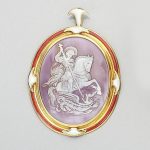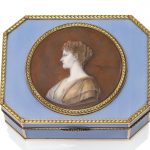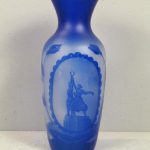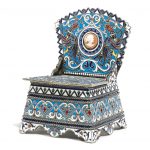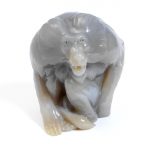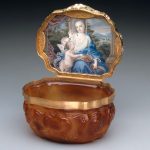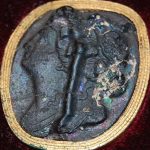Russian cameos have a style all of their own. Russian makers such as Faberge are excellent goldsmiths and their cloisonne is superb. Below are some examples of Russian cameos and cameo glass.
A 19th century shell cameo pendant Russian the oval shell cameo carved to depict George and the dragon, within a red enamelled mount with white enamel axe-head shape applied highlights, makers initials M.P, stamped on the bale, length 5.6cm.
Sold for £352 inc. premium at Bonhams in 2003
Russian Cameo Glass Vase. Chips on top. Russian homeland motif. Unsigned. 5″Dia. X 11.5″tall. Private collection of a Russian family, Catskills NY.
Sold for $325 at Hutter Auctions NYC in 2018
A silver-gilt and cloisonné enamel salt chair, Dmitri Egorov, Moscow, 1895 decorated with polychrome foliage on turquoise grounds, the back with two cockerels flanking a shell cameo, probably later applied, 84 standard height 10.5cm, 4 1/8 in.
Sold for 2,500 GBP at Sotheby’s in 2016
Grey chalcedony baboon with rose-cut diamond eyes. Black leather case. The two halves of the lid are lined in white silk and enclose a fitted mount in cream velvet. There is no name on the silk.
Carl Fabergé used many types of hardstone to make lively and humorous depictions of animals for an aristocratic clientele. Queen Alexandra assembled a celebrated collection and her husband King Edward VII commissioned Fabergé to produce models of the favourite animals at Sandringham. Fabergé’s London branch sold about 250 models of animals between 1907 and 1917.
Reference: © Victoria and Albert Museum
